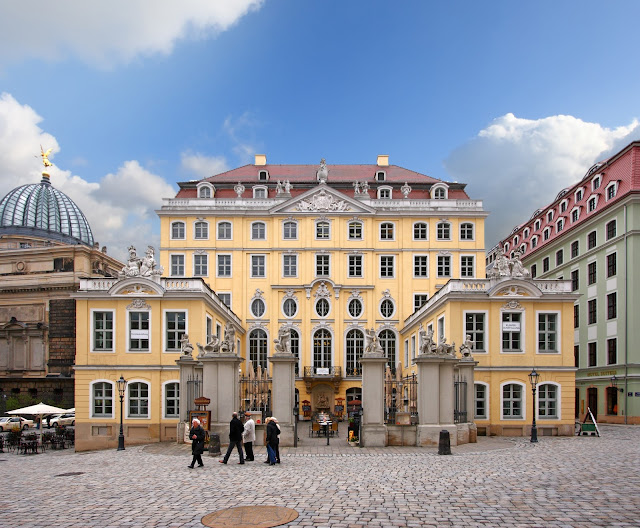 |
| Coselpalais. Image: Wikimedia Commons |
Coselpalais is one of the grandest baroque palaces in
Dresden. It stands in front of the Frauenkirche and demands as much attention
as the other nearby structures.
In 1560, a structure that served as a windmill, and later a
tower, was erected on the site of the Coselpalais. The Saxon Elector Frederick
Augustus gave the building to Johann Christoph Knöffel, chief of the
Oberlandskrieche. The tower was destroyed in 1744, and between 1745 and 1746,
Knöffel built two separate five-storey buildings, which were sadly damaged in
1760 at the height of the Seven Years’ War. One of the two structures to the
Frauenkirche was totally destroyed during the Prussian siege of Dresden on July
19, 1760. It was later rebuilt. The other part had been preserved in ruins and
was integrated into the new Coselpalais building and for the left half of the
Palais was duplicated.
Friedrich Augustus, Imperial Count von Cosel, General of the
Infantry, and a younger half-brother of the Frederick August II, Elector of
Saxony, acquired the two adjoining houses in 1762. Friedrich Augustus was the
only son of King Augustus II the Strong with his mistress, Countess Anna Constanze
von Hoym (the nearby Taschenbergpalais
was the king’s gift to his mistress).
The Count von Cosel commissioned Julius Heinrich Schwarze to
build a residential palace, which was named after him. When Coselpalais was
finally finished, it was hailed as one of the finest baroque structures in
Saxony. The main front was subdivided by pilasters with central risers and
triangles. A festive hall was located on the first floor. The original
structure designed by Knöffel was retained but Schwarz also added two
two-storey side wings. Twelve children's sculptures highlighted the entrance.
From 1845 to 1853 the Russian Hotel was housed here.
Ownership of the palace was transferred to the Kingdom of Saxony in the 1850s
and the palace served as the headquarters of the Saxon police until the police
moved to the newly built Police Department in 1901. Just like much of the structures in the Old
Town, Coselpalais was not spared from the nighttime bombing during World War
II. It was not until 1973 that rebuilding commenced, initially on the wing
buildings. Between 1998 and 2000, the main building was reconstructed which was
finished in February 2002. The palace, now hailed as one of the most remarkable
18th century buildings in Dresden, now houses the Grand Cafe and Restaurant,
one of Dresden’s most sought-after restaurants for its “unrivalled range of
delicious gateaux and freshly baked cakes with choice coffee specialties.”

.png)





0 Comments